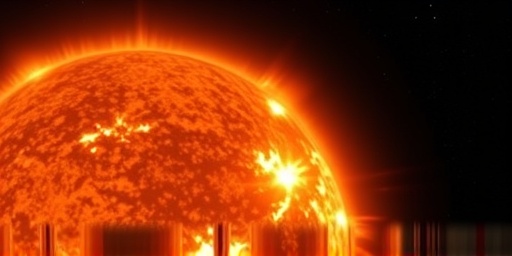In a breathtaking display of the Sun’s raw power, NASA’s Solar Dynamics Observatory (SDO) has captured a massive X-class Solar flare erupting from the Sun’s surface in real-time. The event, which occurred at 17:22 UTC on October 10, 2024, marks one of the most intense solar activities observed this year, sending charged particles hurtling toward Earth and raising alarms about potential disruptions to global communications and power grids.
- The Fiery Burst: NASA’s Real-Time Capture of the Solar flare
- Earth on Alert: How This Solar Flare Could Spark a Geomagnetic Storm
- Unpacking X-Class Flares: The Science Behind the Sun’s Fury
- Global Ripples: Past Solar Flares and Lessons for Today
- Tracking the Aftermath: What Lies Ahead for Solar Monitoring
This sun eruption, classified as an X1.8 flare—the strongest category on the Solar flare scale—originated from Active Region 3842 near the Sun’s eastern limb. Scientists at NASA and the National Oceanic and Atmospheric Administration (NOAA) are closely monitoring the situation, warning that a subsequent geomagnetic storm could intensify within hours, potentially affecting satellites, GPS systems, and even airline routes over polar regions.
The Fiery Burst: NASA’s Real-Time Capture of the Solar flare
The Solar Dynamics Observatory, launched in 2010, is NASA’s premier mission for studying the Sun’s dynamic atmosphere. Equipped with advanced instruments like the Atmospheric Imaging Assembly (AIA), the SDO provided stunning imagery of the solar flare unfolding in extreme ultraviolet light. The flare’s peak intensity lit up the solar disk, with plasma temperatures soaring to over 10 million degrees Fahrenheit, releasing an enormous burst of energy equivalent to billions of hydrogen bombs detonating simultaneously.
According to Dr. Elena Vasquez, a solar physicist at NASA’s Goddard Space Flight Center, ‘This X-class solar flare is a reminder of the Sun’s unpredictable nature. The real-time data from SDO allows us to witness the corona’s magnetic fields twisting and snapping, propelling coronal mass ejections (CMEs) into space.’ The observatory’s continuous monitoring ensures that such events are not just detected but analyzed frame by frame, offering invaluable insights into solar physics.
The timing of this sun eruption couldn’t be more critical, as it coincides with the peak of Solar Cycle 25, which began in December 2019 and is expected to reach its maximum activity around mid-2025. During this cycle, the Sun’s magnetic activity ramps up, leading to increased frequency of solar flares. Historical data from NASA shows that X-class flares occur roughly every few months during solar maximum, but this one’s proximity to Earth—about 93 million miles away—amplifies its potential reach.
Visuals from the SDO, shared widely on NASA’s social media and website, depict the flare as a brilliant white arc against the Sun’s darker backdrop, with loops of plasma arcing back to the surface. These images have already garnered millions of views, sparking public interest in space weather and its earthly consequences.
Earth on Alert: How This Solar Flare Could Spark a Geomagnetic Storm
As the solar flare’s associated CME races toward Earth at speeds up to 2 million miles per hour, experts predict it could trigger a geomagnetic storm within 24 to 48 hours. Geomagnetic storms occur when charged particles from the Sun interact with Earth’s magnetosphere, causing auroras to dance at lower latitudes and, more concerningly, inducing currents in power lines and satellite circuits.
NOAA’s Space Weather Prediction Center has issued a G2 (moderate) geomagnetic storm watch for October 11-12, 2024, with potential escalations to G3 or higher if the CME impacts directly. ‘The orientation of this CME suggests a partial Earth-directed component,’ noted NOAA spokesperson Alex Rivera. ‘We could see radio blackouts on the sunlit side of Earth, lasting from minutes to hours, particularly affecting high-frequency communications used by aviation and maritime operations.’
Potential impacts extend beyond communications. Power grids in high-latitude regions, such as Canada and Scandinavia, face risks from geomagnetically induced currents (GICs), which could overload transformers. A 1989 geomagnetic storm, triggered by a similar X-class flare, caused a nine-hour blackout in Quebec, affecting six million people. Today’s interconnected global grid makes such vulnerabilities even more pronounced.
Satellites are another worry point. The flare’s intense radiation has already prompted operators of GPS and weather satellites to enter safe modes. Companies like SpaceX, with its Starlink constellation, reported minor signal degradations in preliminary assessments. ‘While our network is resilient, events like this underscore the need for robust space weather forecasting,’ said a SpaceX representative in a statement.
To mitigate risks, amateur radio operators and emergency services have been advised to prepare backup systems. In the U.S., the Federal Emergency Management Agency (FEMA) is coordinating with utilities to monitor grid stability, drawing lessons from past events like the 2012 solar superstorm that narrowly missed Earth.
Unpacking X-Class Flares: The Science Behind the Sun’s Fury
Solar flares are sudden explosions of energy on the Sun’s surface, driven by the release of magnetic energy stored in the solar atmosphere. Classified by strength— from A-class (weakest) to X-class (most powerful)—this recent event’s X1.8 rating indicates it packs about 1.8 times the energy of a standard X1 flare. NASA’s data reveals that such flares can release up to 6 × 10^25 joules of energy in mere minutes, dwarfing any human-made explosion.
The mechanics involve twisted magnetic field lines in sunspots reconnecting explosively, accelerating electrons and protons to near-light speeds. These particles, along with electromagnetic radiation, propagate through space. In this case, the flare was accompanied by a CME, a billion-ton cloud of solar plasma that expands as it travels, potentially enveloping Earth in a magnetic bubble upon arrival.
Dr. Marcus Hale, lead researcher on the SDO mission, explained in a recent interview, ‘X-class solar flares like this one are the Sun’s way of venting excess magnetic stress. They provide a natural laboratory for studying plasma physics, which has applications in fusion energy research and understanding stellar evolution.’ Hale’s team has been poring over the data to model the flare’s propagation, using supercomputers to simulate particle trajectories.
Statistically, Solar Cycle 25 has seen 12 X-class flares to date, compared to 28 in the more active Cycle 24. Yet, even one powerful event can have outsized effects. The Carrington Event of 1859, the most famous solar flare in history, disrupted telegraph systems worldwide and painted auroras as far south as the Caribbean. Modern society, reliant on electronics, would face far greater challenges from a repeat.
- Key Characteristics of X-Class Flares:
- Energy Release: Up to 10^32 ergs
- Duration: 10 minutes to several hours
- Associated Phenomena: Radio bursts, X-ray emissions, and often CMEs
- Frequency: Rare, but clustered during solar maximum
Understanding these events is crucial for space weather prediction. NASA’s Heliophysics Division invests heavily in missions like the Parker Solar Probe, which flies closer to the Sun than any spacecraft before, gathering data on flare origins at the source.
Global Ripples: Past Solar Flares and Lessons for Today
This solar flare isn’t an isolated incident; it’s part of a broader pattern of increasing solar activity. In March 2024, another X-class flare from the same active region family disrupted Starlink services temporarily, highlighting vulnerabilities in low-Earth orbit constellations. Similarly, a July 2024 event caused widespread radio blackouts across the Pacific, delaying flights and complicating naval exercises.
Internationally, agencies like the European Space Agency (ESA) and Japan’s JAXA are collaborating with NASA through the International Space Weather Initiative. ‘Shared data from global observatories enhances our predictive models,’ said ESA’s solar monitoring lead, Dr. Sofia Chen. This cooperation was evident in the real-time alerts issued post-flare, allowing allies to adjust satellite orientations preemptively.
Economically, geomagnetic storms pose tangible threats. A 2013 Lloyd’s of London report estimated that a severe solar event could cost the U.S. economy up to $2.6 trillion, factoring in blackouts, satellite losses, and supply chain disruptions. Industries like telecommunications, finance (reliant on precise timing from GPS), and energy are particularly exposed. For instance, the 2003 Halloween solar storms, involving multiple X-class flares, knocked out 47 satellites and caused $1 billion in insurance claims.
Public awareness is growing, too. Apps like NASA’s Space Weather app and NOAA’s alerts have educated millions on solar flare risks. Educational outreach, including virtual tours of the SDO data center, engages students in STEM, fostering the next generation of space weather experts.
Looking ahead, this event underscores the urgency of infrastructure hardening. Governments worldwide are investing in Faraday cages for critical electronics and AI-driven forecasting tools. NASA’s upcoming missions, such as the Vigil spacecraft at the L5 Lagrange point, will provide early warnings of sun eruptions days in advance, potentially averting widespread disruptions.
Tracking the Aftermath: What Lies Ahead for Solar Monitoring
As the CME approaches, NASA’s team is ramping up observations with additional assets like the GOES satellites, which detected the flare’s X-ray flux spiking 1,000 times normal levels. Real-time updates on the NOAA Space Weather Scale will guide responses, with aurora chasers already planning viewings in northern latitudes.
Long-term, this solar flare could influence climate models indirectly, as solar variability affects upper atmospheric chemistry. Researchers are investigating links between geomagnetic storms and ionospheric disturbances that might subtly alter weather patterns.
Stakeholders from tech giants to governments are urged to review contingency plans. ‘Proactive measures today prevent reactive chaos tomorrow,’ emphasized NASA’s Heliophysics Director, Dr. Nicky Fox. With Solar Cycle 25’s peak looming, enhanced international vigilance promises a more resilient planet against the Sun’s cosmic tantrums.
In the coming days, expect detailed post-event analyses from NASA, including 3D visualizations of the sun eruption’s path. These insights will refine models, ensuring better preparedness for the next inevitable flare. As humanity ventures deeper into space—with Artemis missions and Mars ambitions—mastering space weather remains a cornerstone of safe exploration.









